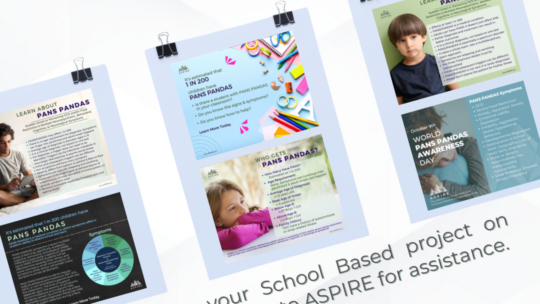
School Based Awareness Projects and Fundraisers
School Awareness Projects The key to a successful capstone project and/or awareness event is to be passionate and committed to the cause. Raising awareness about PANS and PANDAS can...
PANS PANDAS is a medical condition in which symptoms affect a student’s ability to attend school and learn.
Symptomology and symptom severity vary from student to student and even from flare to flare in the same student. The goal of treatment is to achieve full recovery in order to prevent the student’s condition from becoming a chronic, debilitating illness. Treatment includes medical protocols as well as therapeutic practices. School accommodations are an essential component of a thorough and appropriate treatment protocol. Please read the overview of PANS in the school setting below and then follow up with ASPIRE’s Resources for Schools & Educators. Please register for a virtual in-services on PANS PANDAS.
The accommodations vary depending on the student’s symptoms and severity as well as from flare to flare. Each symptom can cause its own set of difficulties at school and when combined with several symptoms, even more significant challenges must be addressed. There is neither a one size fits all presentation of symptoms nor a one size fits all set of accommodations.
Due to the changing nature of symptoms and the relapsing and remitting course of PANS, ensure plans are flexible. Plans should be written with the student’s worst days in mind while hoping for the best days. A student may initially present with one or more primary symptoms, which may resolve with treatment only to be replaced with a new set of symptoms or different manifestations of the initial symptoms. Academic performance and attendance can vary widely during exacerbations.
One month, a student may be in a debilitating flare requiring several supports but later in the school year require significantly less only to relapse again. Not all PANS students return to baseline between flares, requiring year-round accommodations even while not in an active flare. Student performance and needs can vary day-to-day and week-to-week.
Other Health Impairment (OHI) is the condition that most PANS students qualify for an IEP. Students may be eligible for an IEP under different categories as well depending on that student’s symptoms such as specific learning disability (SLD), autism spectrum disorder (ASD) or emotional and behavioral disorder (EBD). However, caution must be taken to not mislabel a student; SLD or EBD may not encompass all of the student’s issues by focusing too much on a small portion of symptoms.
“Writing the plans with the most difficult days in mind will assure that the child can receive adequate accommodations without revisiting the 504 or IEP process often.”
Clinical Management of Pediatric Acute-Onset-Neuropsychiatric Syndrome: Part I–Psychiatric and Behavioral Interventions, Margo Thienemann, MD et al

School Awareness Projects The key to a successful capstone project and/or awareness event is to be passionate and committed to the cause. Raising awareness about PANS and PANDAS can...
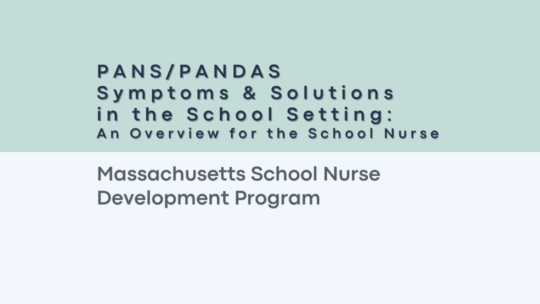
Presentation Details PANS/PANDAS Symptoms and Solutions in the School Setting: An Overview for the School Nurse Presenter: Gabriella True, ASPIRE President Addendum Topic: Massachusetts...
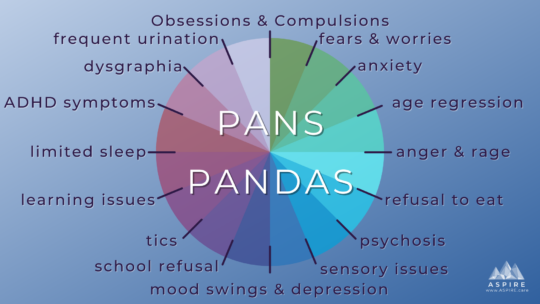
Learn more about PANS PANDAS PANS PANDAS are misdirected immune responses that result in acute onset of OCD, tics, and/or restricted food intake, along with two neuropsychiatric symptoms in seven...

Students with PANS/PANDAS have complex cognitive, behavioral, physical & neurological symptoms that affect their school performance. The school's multidisciplinary team benefits from an awareness of...

PANS PANDAS Comprehensive Educator Toolkit for School Staff, Teachers, and School Nurse PANS PANDAS in the School Setting – Impacts and Supports This PANS PANDAS Comprehensive Educator...
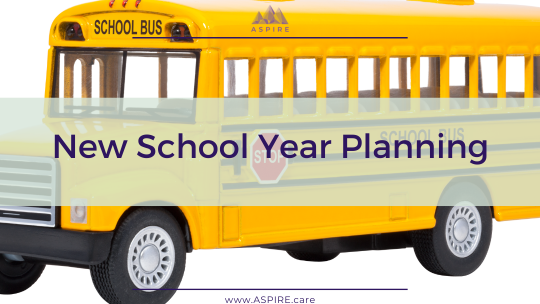
A the start of a school year parents of students with PANS PANDAS should schedule a time to meet with their child’s new team including teachers, therapists, guidance counselors, etc. If the student...

Speaker: Shara Virlan, MA Educational Leadership, WI Reading Teacher 316, BS Elementary Education 1-6, EC NK Webinar: Essential Strategies for Navigating Special Education Date/Time: August 23rd,...

Dissertation Study Enrollment: Mary Crombez, Madonna University Doctoral Candidate, is working on a new research study to complete a doctorate in Doctor of Education (EdD) in Leadership and...

Speaker: Jennifer Leiman, MS, OTR/L Webinar: Executive Function Tools: Before, During, & After a PANS PANDAS Flare View this webinar: Executive Functioning Webinar Abstract: Connecting...
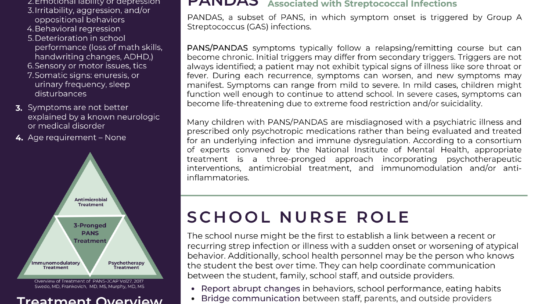
This handout on School Nurse Information is the perfect accompaniment to the PANS PANDAS in the School Setting 2-page handout. We also have a 20-page toolkit PANS PANDAS School Impact &...
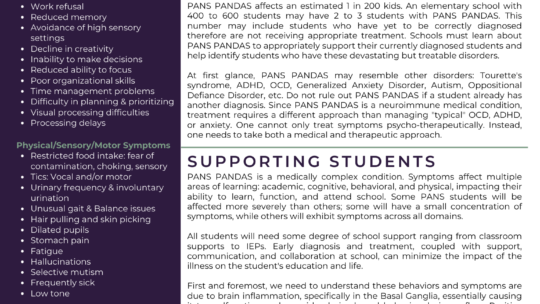
This two-page handout on PANS PANDAS in the school setting is a perfect introduction to school staff and families. We also have a twenty-page toolkit PANS PANDAS School Impact &...

PANS PANDAS in the School Setting Toolkit Information at your fingertips Click the button below to download the twenty-page toolkit that provides information on School Impacts and Supports for PANS...